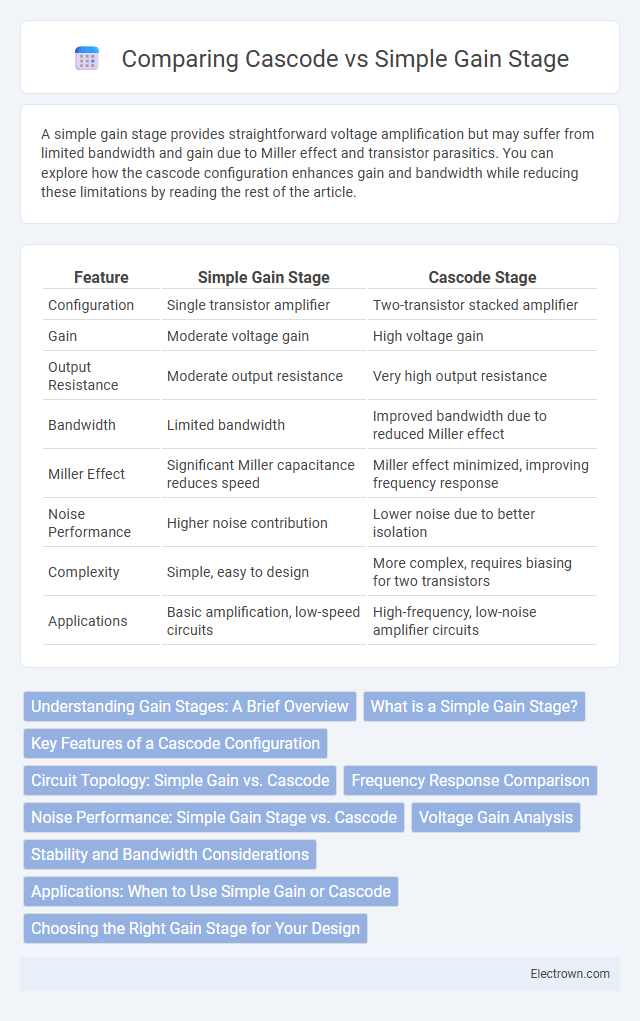A simple gain stage provides straightforward voltage amplification but may suffer from limited bandwidth and gain due to Miller effect and transistor parasitics. You can explore how the cascode configuration enhances gain and bandwidth while reducing these limitations by reading the rest of the article.
Table of Comparison
| Feature | Simple Gain Stage | Cascode Stage |
|---|---|---|
| Configuration | Single transistor amplifier | Two-transistor stacked amplifier |
| Gain | Moderate voltage gain | High voltage gain |
| Output Resistance | Moderate output resistance | Very high output resistance |
| Bandwidth | Limited bandwidth | Improved bandwidth due to reduced Miller effect |
| Miller Effect | Significant Miller capacitance reduces speed | Miller effect minimized, improving frequency response |
| Noise Performance | Higher noise contribution | Lower noise due to better isolation |
| Complexity | Simple, easy to design | More complex, requires biasing for two transistors |
| Applications | Basic amplification, low-speed circuits | High-frequency, low-noise amplifier circuits |
Understanding Gain Stages: A Brief Overview
Simple gain stages typically use a single transistor to amplify signals, offering straightforward design and moderate gain but limited bandwidth and gain stability. Cascode gain stages combine a common-emitter transistor with a common-base transistor, resulting in higher gain, increased bandwidth, and improved output impedance while reducing the Miller effect. Understanding these distinctions enables optimized amplifier designs that balance gain, frequency response, and noise performance in analog circuits.
What is a Simple Gain Stage?
A simple gain stage is a basic amplifier configuration that uses a single transistor to amplify an input signal, providing voltage gain with straightforward design and minimal components. It offers moderate gain and wide bandwidth but can suffer from limitations like Miller effect, which reduces high-frequency performance. Your choice of a simple gain stage is ideal for applications requiring ease of implementation and low power consumption without demanding high-frequency precision.
Key Features of a Cascode Configuration
A cascode configuration combines a common-emitter stage with a common-base stage, significantly improving gain bandwidth and input-output isolation compared to a simple gain stage. It offers high gain, reduced Miller effect capacitance, and improved frequency response, making it ideal for high-frequency amplification. The cascode also provides better linearity and higher output impedance, enhancing overall amplifier performance in RF and analog circuits.
Circuit Topology: Simple Gain vs. Cascode
Simple gain stages use a single transistor to amplify signals, offering straightforward circuit topology with moderate gain and reduced voltage headroom. Cascode configurations combine a common-emitter stage with a common-base stage, enhancing gain by improving output impedance and bandwidth while minimizing Miller effect capacitance. The cascode's two-transistor topology delivers higher gain and better frequency response compared to the simple gain stage's single-transistor design.
Frequency Response Comparison
The cascode amplifier significantly improves frequency response by reducing the Miller effect, which lowers input capacitance and extends the bandwidth compared to a simple gain stage. A simple gain stage suffers from higher parasitic capacitances that degrade high-frequency performance, limiting its effective range. Consequently, the cascode configuration enables higher gain at elevated frequencies, making it ideal for high-speed and RF applications.
Noise Performance: Simple Gain Stage vs. Cascode
A simple gain stage typically exhibits higher noise levels due to its single transistor configuration, which allows more thermal and flicker noise to directly impact the output. In contrast, the cascode configuration significantly improves noise performance by isolating the input transistor from output voltage variations, reducing Miller effect and associated noise gain. For applications requiring lower noise and higher gain stability, your choice of a cascode stage can provide superior signal integrity.
Voltage Gain Analysis
A simple gain stage typically provides voltage gain limited by transistor parameters and load resistance, often suffering from Miller effect capacitance that reduces bandwidth. The cascode configuration enhances voltage gain by combining a common-emitter stage with a common-base stage, which significantly increases output impedance and minimizes Miller capacitance impact. Your circuit can achieve higher voltage gain and improved frequency response by using a cascode over a simple gain stage.
Stability and Bandwidth Considerations
Simple gain stages offer straightforward design and moderate bandwidth but often suffer from limited stability due to higher Miller capacitance effects. Cascode configurations enhance stability and significantly increase bandwidth by reducing the Miller effect and improving gain-bandwidth product. When optimizing Your amplifier for high-frequency applications, the cascode stage provides superior performance in maintaining stable, wideband operation.
Applications: When to Use Simple Gain or Cascode
Simple gain stages are ideal for low-frequency amplification and applications requiring minimal circuit complexity, such as audio amplifiers and basic signal conditioning. Cascode configurations excel in high-frequency scenarios and RF circuits, providing improved bandwidth, gain stability, and reduced Miller capacitance, making them suitable for communication systems and high-speed analog designs. Choosing between them depends on frequency requirements, noise performance, and gain needs in specific applications.
Choosing the Right Gain Stage for Your Design
Simple gain stages offer straightforward implementation and lower power consumption, making them ideal for designs prioritizing simplicity and efficiency. Cascode configurations provide higher gain, increased bandwidth, and improved output impedance, suitable for high-frequency and low-noise applications. Selecting the right gain stage depends on balancing design goals such as gain requirements, frequency response, power constraints, and circuit complexity.
Simple gain stage vs cascode Infographic

 electrown.com
electrown.com